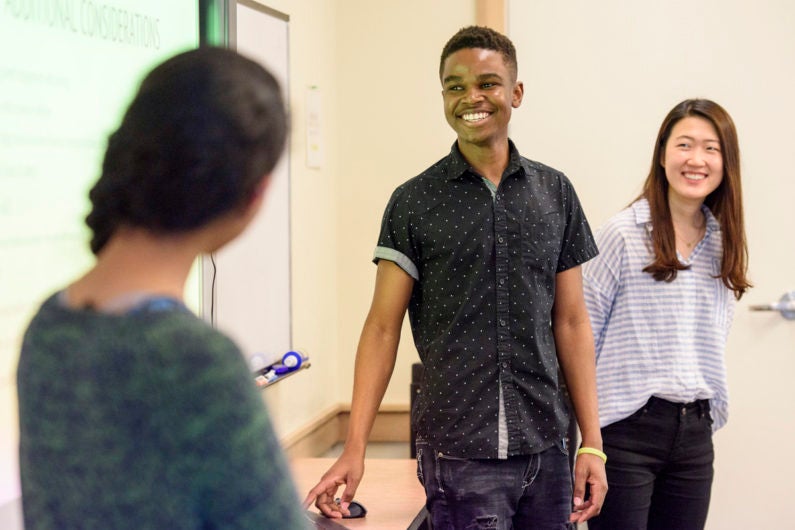Stanford students propose new ways to put technology to work addressing poverty and inequality
Students enrolled in Ending Poverty with Technology explored answers to the question: Can we harness new technologies to reduce poverty and inequality?
As the Stanford students enrolled in Ending Poverty with Technology considered which problems to tackle in the vast landscape of poverty, they chose issues close to their hearts, from hunger in communities near campus to the distribution of counterfeit seeds to small farmers in Africa.

Helen Park, right, and Timothy Tatenda Mazai chat with Mayuka Sarukkai about their project to help low-income families trade childcare services. (Image credit: L.A. Cicero)
One group of students – Timothy Tatenda Mazai, ’18, Helen Park, ’17, and Mayuka Sarukkai, ’19 – came together over a common passion for improving the lives of children by improving the accessibility and affordability of childcare.
“In the ‘land of opportunity’ it only makes sense that every human being has access to the same resources and pathways to success – an ideal we are far from achieving,” said Sarukkai, who is majoring in symbolic systems.
“Research literature points to the importance of the first five years in shaping the trajectory of entire lives and we felt really passionate about focusing our efforts around a child’s first few years. Childcare also seemed like a real cool opportunity to use technology to augment existing social patterns, rather than replacing them – a kind of inversion of some of the more detrimental effects of technology that prioritizes uplifting invaluable human resources rather than transplanting them.”
As their capstone project, the team proposed a web platform and mobile app called CareSwap, which was designed to help low-income families trade childcare services within their trusted networks of friends, neighbors and family.
The Ending Poverty course was one of more than 160 Cardinal Courses offered this year. Cardinal Courses, which integrate rigorous coursework with real-world service experience, are a singular feature of a Stanford undergraduate education.
While the course has ended for the academic year, the CareSwap team plans to continue developing the web platform and mobile app.
“Our idea evolved so much in the last few months after our interviews and conversations with parents and childcare experts,” the students said. “We are excited to develop it further next year. This project has become far more than a class assignment for each of us.”
Tackling real-world problems
In offering Ending Poverty, David Grusky, a professor of sociology and director of the Stanford Center on Poverty and Inequality, knew he would be presenting undergraduate students with a daunting task.
“In this course, students are not just asked to master a rapidly developing basic science on poverty, but also to understand the complicated programs and interventions that have been developed in the United States and elsewhere to reduce poverty,” said Grusky, who is also a senior fellow at the Stanford Institute for Economic Policy Research.
“But we’re asking more of them than even that. We’re then asking them to figure out, based on what they have learned, how to intervene successfully and actually reduce poverty. To jump into a complicated field, to master it, and then to creatively develop new interventions – that’s a big ask.”
To inspire students, Grusky invited key leaders in the nonprofit and technology industries in Silicon Valley to discuss the ways entrepreneurs are tackling poverty with technology.
A shared mission
Grusky said he and the students, whom he described as “brave, bold and persistent” in their quest to put technology to use reducing poverty and inequality, shared a single mission during the two-quarter course.
“It’s not about a professor teaching and the students learning,” he said. “We’re all just part of the same team trying to build products that work to reduce poverty.”
Some of the students proposed apps, including one that would allow students to donate the unused meals on their meal plans to low-income families, and another that would encourage wealthy millennials to ramp up their charitable giving.
Other students proposed web platforms, including one that would help low-income individuals find pro bono lawyers. One student proposed combining several technologies – smartphones, artificial intelligence and machine learning – to identify and drive out counterfeit agricultural seeds in Kenya.
Grusky said some of the proposed projects may be adopted for further development by the Stanford Poverty & Technology Lab, a fledgling initiative dedicated to developing technology-based solutions to rising inequality in the United States.
The lab is developing an app, under the leadership of Bill Behrman, director of the Stanford Data Lab, for “mapping” poverty in California. The app could help government agencies and nonprofit organizations better target services by delivering estimates of poverty, unemployment, income and other indicators for very small geographic areas of the state.
During the class, Dorian Pickens, ’18, contributed to the development of the mapping app by interviewing possible users about the types of data and visualization that would be most helpful in their work.
“Hopefully, the work I contributed can be used to continue developing the project,” said Pickens, who is majoring in communication. “It should be quite exciting to see what the future holds.”
